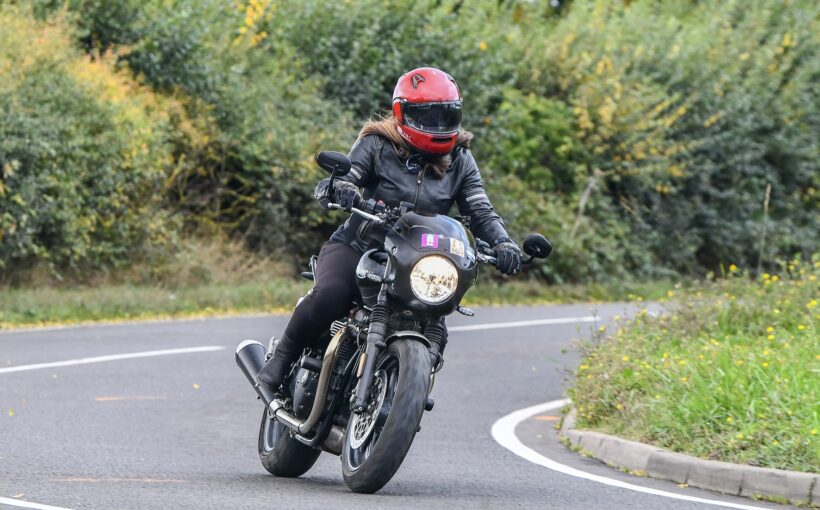I attended a joint Bike Safe and Biker Down workshop at the Joint Emergency Services Academy in Stevenage run by BCH Roads Policing, Stevenage which is the Joint Protective Services for Bedfordshire Police, Cambridgeshire and Hertfordshire Constabularies and Herts Fire & Rescue.
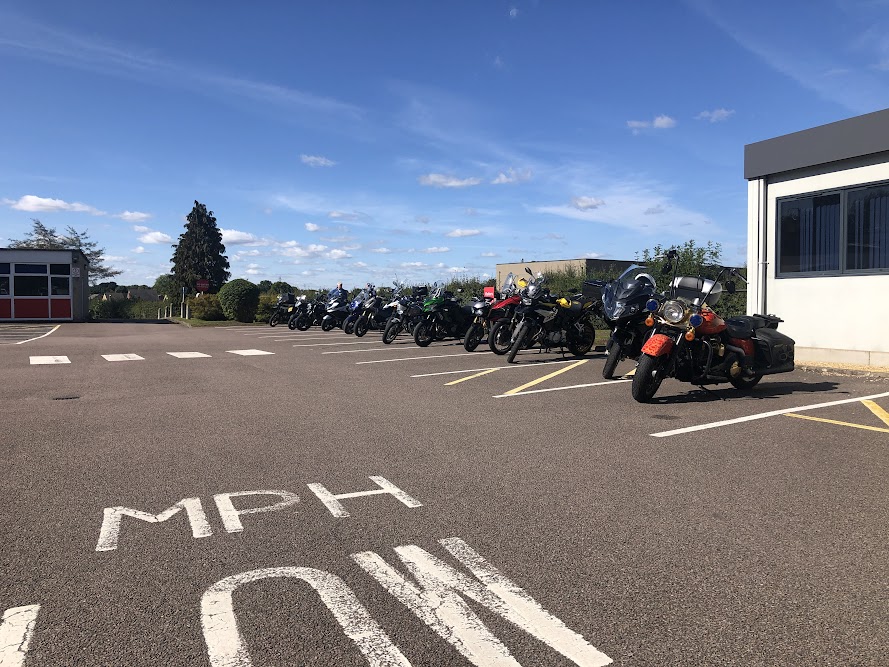
In the morning we had the Bike Safe workshop which consisted of three parts:
- Online eLearning (90 minutes)
- Theory workshop
- Observed ride
Bike Safe Workshop
Prior to the workshop I received an email from Bike Safe with details of how the course would run and also a link to the three videos they request you to watch prior to the course. The online videos were created at the beginning of 2020 as part of an initiative to standardise the course, meaning that in theory you now receive the same content whichever force area you attend.
The three videos contain nine eLearning modules, each module is 10-15 minutes long. Don’t worry, you don’t need to watch all the modules in one go!
So what are the modules then?
- Behaviour & Attitude
- The System of Motorcycle Control
- Observation
- Cornering
- Overtaking
- Filtering
- Junctions
- Group Riding
- Hazards
It may seem like a lot of information to take in watching the videos but a lot of what is said makes sense and I think we pretty much do a most of what is covered without actually realising that we are doing it.
If you like, it makes you take a step back and think about your riding and how/why we do what we do when riding and just the amount of information we are taking in.
So I arrived for my workshop and signed in. PC Mark Fairclough was heading the course today. Mark has been a police officer for 14 years and has been an advanced rider for 8 years and has recently become a VIP rider. Mark also holds a RoSPA diploma in motorcycle riding, is an instructor on the DVSA enhanced rider scheme and offers one to one bike safe courses.
Mark gave a brief overview of what we should expect from the day.
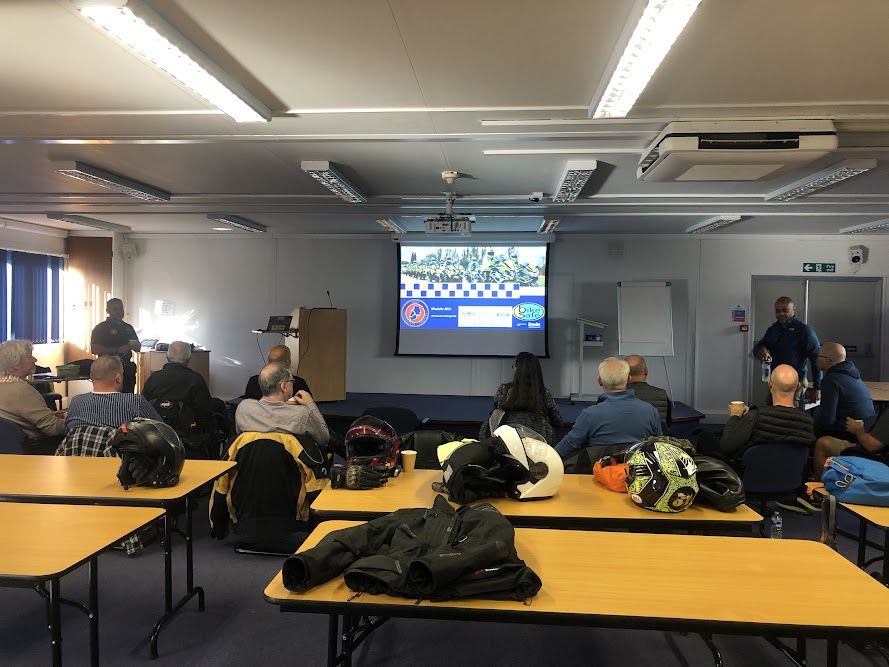
To start with we went around the room and introduced ourselves, what bikes we were riding and why we were doing the workshop. Mark said the fact that we were there meant that we had taken the first step to becoming a better, safer rider.
The Bike Safe workshop is based on the Police Motorcycle Roadcraft manual. The aim of the course is to cover our knowledge of the highway code and to understand how our behaviour and attitude affects our riding.
To give you a little bit of history here, after WWII a lot of the people that left the army got jobs as police officers, firefighters and ambulance crew. They were handed keys to police cars, fire engines and ambulances having had no formal training of how to drive them. As a result there were a lot of casualties so it was decided to introduce driver training.
People from different areas were consulted such as racing drivers, and a set of guidelines were drawn up, this was known as Road Smart. This developed over the years and the system used at the core of advanced riding is known as IPSGA : Information, Position, Speed, Gear and Acceleration. The competencies framed by IPSGA are Core Riding Skills, Bends, Junctions and Roundabouts, Overtaking, Motorways and Dual Carriageways and Slow Riding.
A fact for us to think about:
- 2% of UK road users are bikers
- 20% of bikers as road users are killed or seriously injured each year
- 50% of those collisions involve just the bike
Mark said that we should be thinking about our mindset before going out on the bike, psychological stresses will have an impact on our riding. We should acknowledge that our attitude can affect our riding. We need to understand and appreciate our vulnerability as a rider and be able to learn from our mistakes and experiences.
We talked about the highway code. This applies to everyone!
One question that often gets asked is ‘Is it law to wear protective gear whilst riding a motorcycle?’ According to rules 83-88 of the Highway Code rules for motorcyclists:
- No, the one legal requirement is that both the rider and the pillion must always wear a protective helmet.
- They are advised to wear eye protectors, which must comply with regulations
- Ear protection should be considered
- ‘Strong boots, gloves and suitable clothing may help to protect you if you are involved in a collision.’ This is an advisement.
- Rule 86 suggests that riders make themselves as visible as possible from the side, as well as the front and rear, and that they could wear ‘a light or brightly coloured helmet and fluorescent clothing or strips’.
- Rule 87 says that when riding in the dark, you should ‘wear reflective clothing or strips to improve your visibility.’
We then talked about each of the nine modules from the online videos that we watched before coming on the workshop. Mark went into more detail on each of the subjects giving insights, hints, tips and advice. It is this kind of information that I think is invaluable.
You can watch or read up on these areas yourself but I think when we are talking to other people or listening to the experiences of others, this is when we learn the most. Others in the group were able to recount their experiences too and discussions then took place. I really love this aspect about workshops.
Biker Down Workshop
In the afternoon, we had the Biker Down workshop.
What is Biker Down I hear you ask?
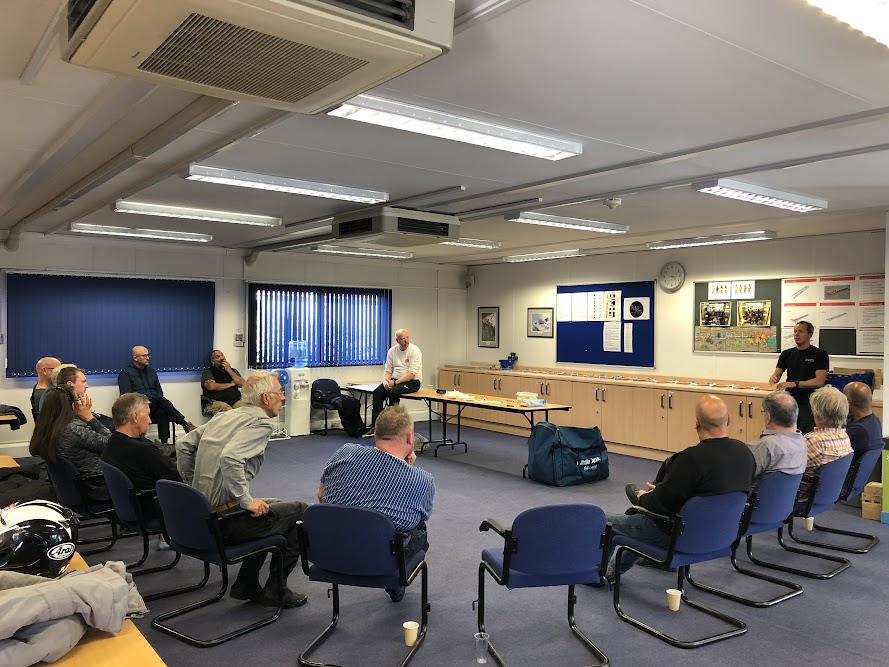
Hertfordshire Fire & Rescue Service have what is known as a Fire Bike Team which is “Run by volunteers dedicated to reducing the number of motorcyclists killed or seriously injured on Hertfordshire roads”.
Hertfordshire are not the only county to have a fire bike team, pretty much all the services do across the country so you should be able to find one near you, Hertfordshire is my nearest one.
This team of volunteers put on various different courses:
Assessed Rides: these are offered by staff qualified to IAM national observer level, the purpose of which is to achieve the following:
- Improve skill levels
- Learning opportunity
- Advice on further training
- Constructive critique of current riding level
This is a free service to all riders which is offered to all ages and riding abilities, from learners to experienced riders.
I had one to one training with one of these guys not long after I passed my test as I was having issues with cornering and I have to say this additional training helped me so much, not only did my cornering improve significantly but also my riding.
Rider Skills Training: qualified observers provide supervised activities to promote safer riding skills for new and experienced riders in the following areas:
Slow Riding : learn slow riding techniques, improving manoeuvring skills and control leading to safer riding and confidence in traffic conditions;
Cornering Skills: this teaches the science of cornering, covering counter steering, throttle control, enabling understanding the physics of bike control.
Education: fire bike volunteers support the road safety work of the Herts Road Safety Partnership which includes Herts County Council, Herts Police and Fire Service by supporting the following activities:
- Open days
- Ride outs
- Community events
- College visits
- Lectures
- Road safety events
Biker Down: this is a free course giving information on what to do at the scene of a motorcycle accident such as:
- Scene management;
- Life saving actions;
- Science of being safe.
Today’s Biker Down workshop was run by Tony Smith, who is the Team Leader, with his very lovely assistant, Andy.
The Biker Down course was initially put together by Jim Sanderson from Kent Fire & Rescue Service some 22 years ago. Jim witnessed a motorcycle accident whilst off duty and used his own training as a fire fighter to assist at the scene.
Jim decided that that he should share his skills and knowledge with fellow bikers, hence the Biker Down scheme was born.
Tony explained that in today’s session there would be three parts to this course:
- First on the scene
- Basic life support
- The thinking biker
Andy would be guiding us through what we should do if we were to come upon the scene of accident that has just happened. There are four main areas:
- Priorities
- Scene management
- Life saving actions
- Handover
The main thing we should remember is not to panic – way easier said than done! We need to take control of the situation, see who else is on the scene who may be able to assist us and remember that early action can save a life.
We must remember that the scene of an accident is a dangerous place to be! There is moving traffic, there may be fire, debris on the road, other people moving around, adverse weather conditions.
Interestingly, Andy said we should keep our own crash helmet and gloves on to start with as this will protect our own face and hands from the possibility of being injured until we know the situation, there could be the possibility of biohazards and not just chemicals but also (and look away at this bit if you are squeamish) blood and guts!
We should make sure the scene is safe but must always consider our own safety first, after all you are not going to be any help to anyone if you injure yourself trying to get to someone without first checking that it is safe to do so.
If there are other people around, designate them with jobs to do for example, traffic management, looking for other casualties, calling the emergency services etc.
A top tip from Andy is that a biker should stay down until a paramedic arrives and can assess their injuries and decide how best to proceed with the casualty.
If the biker’s crash helmet has received significant damage then ideally this should go with the casualty in the ambulance so the doctors can look at the impacted areas.
Another top tip is that if the casualty is conscious when you first speak to them, get their personal information – full name, date of birth, next of kin etc and if possible write this down. This way if the casualty passes out you have their information that you can pass on to the paramedics.
The final module, the thinking biker, was a video that we watched. This looks at the way the brain interprets data sent by the eye so that what’s visible isn’t always seen, for example, motion camouflage, saccadic masking and looming.
The video offers positive advice on how to make the most of our chances of being seen. It puts the point over quite clearly that hi-vis clothing, day riding lights and retro-reflective materials don’t guarantee we’ll be seen by other road users. Very interesting video indeed.
So that was both the workshops completed. Next was my observed ride. Oo er!!!
Observed Ride
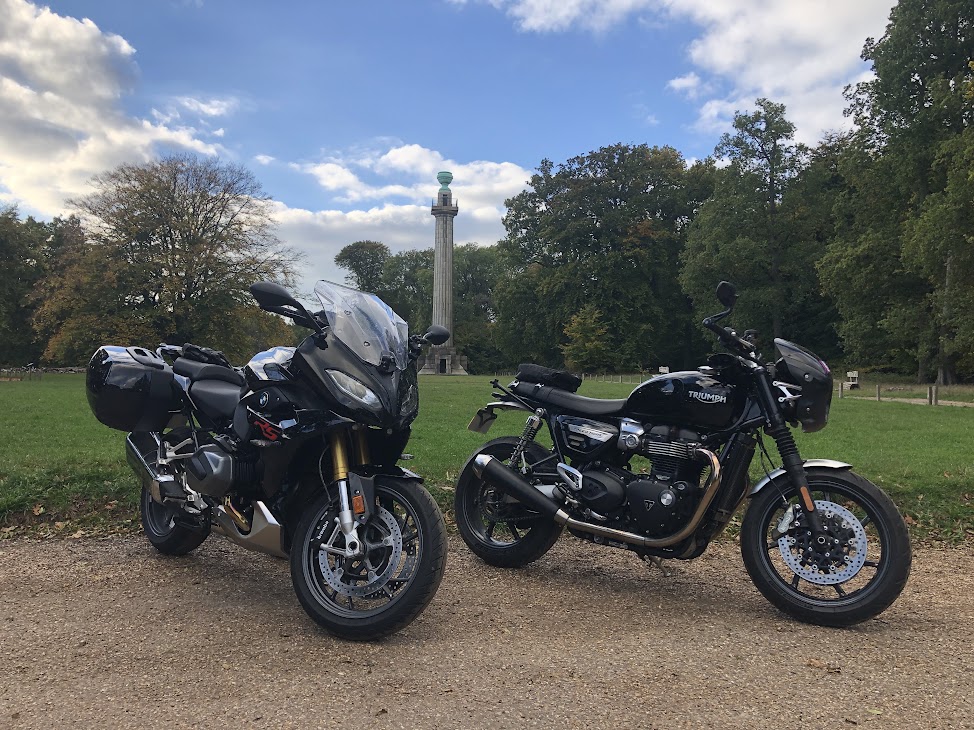
My observer was Sgt Russ Jones, who I met up with one afternoon. After a general chit chat Russ asked about my riding history, the bikes I rode and how often I rode to gather an idea of what kind of riding I do.
Russ explained that we would go for approximately an hour’s ride, stop for a coffee (I was definitely on board with this aspect) so Russ could give me some observations about my riding and if necessary pointers to work on, and then we would ride back and Russ would give me feedback on the session.
Okay. Nothing to worry about! I decided that if I tried to forget that Russ was a police officer who was going to be following me and was just a biker and we were going for a ride, then hopefully I wouldn’t be as nervous.
Yeah, that only kind of worked. I knew I was a little nervous going but I suppose that is only natural. We sat down for a coffee and I waited in anticipation for what Russ had to say.
All in all a good ride (phew!) There were a few occasions where I overlapped my gears and braking. Russ would like to see me approach junctions slower in order to raise my view with the idea being that I keep the bike moving instead of stopping. Try and keep the momentum going and this will make for a smoother exit.
Russ would also like to see me straight lining bends if possible when safe to do so and the view is available – the bike is most stable when it’s upright.
Ultimately I did a safe ride.
Okay, that wasn’t so bad, I was pretty chuffed with myself about those observations.
After coffee, we headed back to the bikes for our ride back. My nerves had disappeared by now and I felt I had a great ride back, I was more relaxed and I felt Russ could really observe how I actually ride.
I had put into practice what Russ said about approaching junctions slower and keeping the momentum going, when we parked up I said to Russ that I could feel how much smoother my riding was at junctions.
My feedback comments were:
Junctions: Open your view and take approach slower, aim to keep the bike moving.
Cornering: Overall good positioning. Consider straight lining when safe and view is available. Remember your bike is most stable when upright and in a straight line at a constant steady speed.
Filtering: No opportunities.
Overtaking: Good overtakes on our return from Thame. Good use of 3 stage overtake. Try not to overtake into a slower speed limit.
Awareness: Consider alternate position when road surface is poor.
Speed: Good use of speed.
Controls: Good.
Signs & signals: Good.
Attitude & responsibility: Good.
Russ would put my riding level between levels A and B.
Level A is: a high level of riding ability demonstrating consistently safe and responsible riding in all key areas. A well structured and executed ride giving evidence that systematic planning is being employed consistently and automatically.
Level 2 is: a good level of riding ability demonstrating safe and responsible riding. A structured ride based on systematic planning with few minor errors.
I’m happy with that. In fact I’m quite pleased with myself. A few things for me to work on but I think you can always improve on your riding and be open to learning new things. We can all strive to become better, safer riders.
I would just like to say thank you to Russ, Mark, Tony and Andy for their time. I really enjoyed doing the Bike Safe and Biker Down workshops, I found them really interesting and incredibly useful.
If you are thinking about doing either or both of these courses, then do it, I definitely recommend all bikers doing these courses no matter your age or riding experience.
BK

